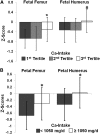Maternal vitamin D status and calcium intake interact to affect fetal skeletal growth in utero in pregnant adolescents
- PMID: 22492380
- PMCID: PMC3325835
- DOI: 10.3945/ajcn.111.023861
Maternal vitamin D status and calcium intake interact to affect fetal skeletal growth in utero in pregnant adolescents
Abstract
Background: Maternal calcium intake and vitamin D status may affect fetal bone development.
Objective: This study was designed to examine relations between maternal calcium intake, 25-hydroxyvitamin D [25(OH)D] status, and fetal bone growth across pregnancy.
Design: This was a prospective longitudinal design. Maternal 25(OH)D, parathyroid hormone, and 1,25-dihydroxyvitamin D [1,25(OH)(2)D] were determined at midgestation (∼26 wk) and at delivery in 171 adolescents (≤ 18 y). Dietary recalls and fetal sonograms were performed up to 3 times across gestation, and fetal femur and humerus z scores were generated.
Results: Fetal femur and humerus z scores and neonatal birth length were significantly greater (P < 0.03) in adolescents consuming ≥ 1050 mg than in those consuming <1050 mg Ca/d. Maternal 25(OH)D > 50 nmol/L was significantly positively associated with fetal femur and humerus z scores (P < 0.01). When maternal smoking, height, race, weight gain, and gestational age were controlled for, these relations remained significant. Interactions between calcium intake and 25(OH)D were evident. Calcium intake was associated with fetal femur z scores and birth length only when maternal 25(OH)D was ≤ 50 nmol/L (P < 0.05). Similarly, maternal 25(OH)D was associated with fetal femur and humerus z scores only when maternal calcium intake was <1050 mg/d (P < 0.03).
Conclusions: Optimal calcium intake and adequate maternal vitamin D status are both needed to maximize fetal bone growth. Interactions between these nutrients were evident when either calcium or vitamin D status was limited. Improving maternal calcium intake and/or vitamin D status during pregnancy may have a positive effect on fetal skeletal development in pregnant adolescents.
Figures





Similar articles
-
Calcium Plus Vitamin D Supplementation During the Third Trimester of Pregnancy in Adolescents Accustomed to Low Calcium Diets Does Not Affect Infant Bone Mass at Early Lactation in a Randomized Controlled Trial.J Nutr. 2015 Jul;145(7):1515-23. doi: 10.3945/jn.114.208140. Epub 2015 May 27. J Nutr. 2015. PMID: 26019245 Clinical Trial.
-
Interactions between Vitamin D Status, Calcium Intake and Parathyroid Hormone Concentrations in Healthy White-Skinned Pregnant Women at Northern Latitude.Nutrients. 2018 Jul 17;10(7):916. doi: 10.3390/nu10070916. Nutrients. 2018. PMID: 30018262 Free PMC article.
-
Placental vitamin D receptor (VDR) expression is related to neonatal vitamin D status, placental calcium transfer, and fetal bone length in pregnant adolescents.FASEB J. 2014 May;28(5):2029-37. doi: 10.1096/fj.13-246736. Epub 2014 Feb 20. FASEB J. 2014. PMID: 24558197
-
Vitamin D Supplementation during Pregnancy: An Evidence Analysis Center Systematic Review and Meta-Analysis.J Acad Nutr Diet. 2020 May;120(5):898-924.e4. doi: 10.1016/j.jand.2019.07.002. Epub 2019 Oct 25. J Acad Nutr Diet. 2020. PMID: 31669079
-
Maternal and Foetal Health Implications of Vitamin D Status during Pregnancy.Ann Nutr Metab. 2018;72(3):179-192. doi: 10.1159/000487370. Epub 2018 Mar 13. Ann Nutr Metab. 2018. PMID: 29533937 Review.
Cited by
-
Perspectives on the systematic review for the 2020 Dietary Reference Intakes for Koreans for calcium.Nutr Res Pract. 2022 May;16(Suppl 1):S89-S112. doi: 10.4162/nrp.2022.16.S1.S89. Epub 2022 Feb 14. Nutr Res Pract. 2022. PMID: 35651839 Free PMC article. Review.
-
Association of first trimester maternal vitamin D, ferritin and hemoglobin level with third trimester fetal biometry: result from cohort study on vitamin D status and its impact during pregnancy and childhood in Indonesia.BMC Pregnancy Childbirth. 2019 Apr 2;19(1):112. doi: 10.1186/s12884-019-2263-1. BMC Pregnancy Childbirth. 2019. PMID: 30940099 Free PMC article.
-
Maternal calcium metabolic stress and fetal growth.Am J Clin Nutr. 2014 Apr;99(4):918-25. doi: 10.3945/ajcn.113.076034. Epub 2014 Feb 5. Am J Clin Nutr. 2014. PMID: 24500145 Free PMC article. Clinical Trial.
-
Longitudinal Maternal Vitamin D Status during Pregnancy Is Associated with Neonatal Anthropometric Measures.Nutrients. 2018 Nov 2;10(11):1631. doi: 10.3390/nu10111631. Nutrients. 2018. PMID: 30400155 Free PMC article.
-
The effect of maternal vitamin D concentration on fetal bone.J Clin Endocrinol Metab. 2012 Nov;97(11):E2070-7. doi: 10.1210/jc.2012-2538. Epub 2012 Sep 18. J Clin Endocrinol Metab. 2012. PMID: 22990090 Free PMC article.
References
-
- Lee JM, Smith JR, Philipp BL, Chen TC, Mathieu J, Holick MF. Vitamin D deficiency in a healthy group of mothers and newborn infants. Clin Pediatr (Phila) 2007;46:42–4 - PubMed
-
- O'Riordan MN, Kiely M, Higgins JR, Cashman KD. Prevalence of suboptimal vitamin D status during pregnancy. Ir Med J 2008;101:240, 242–3 - PubMed
-
- Lucas RM, Ponsonby AL, Pasco JA, Morley R. Future health implications of prenatal and early-life vitamin D status. Nutr Rev 2008;66:710–20 - PubMed
-
- Prentice A. Micronutrients and the bone mineral content of the mother, fetus and newborn. J Nutr 2003;133:1693S–9S - PubMed
Publication types
MeSH terms
Substances
Grants and funding
LinkOut - more resources
Full Text Sources
Medical
Miscellaneous

